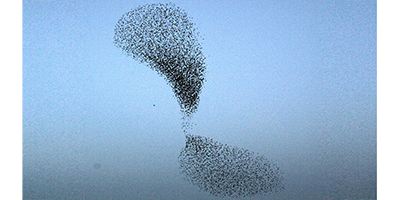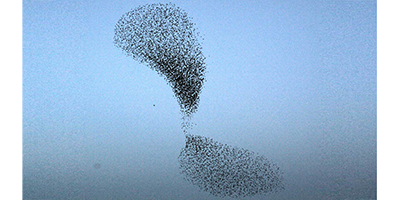Silent Flocks
Birds of a feather flock together by sharing information about their trajectory. Scientists try to model this form of communication with waves that travel through the flock at high speed. A new analysis shows that different types of waves may operate for small vs large flocks, but intermediate-sized flocks might not support any sort of wave. Because these “silent flocks” can’t coordinate their movements, they would likely fly apart, which may explain why bird flocks seem to obey certain size constraints.
Previous work on collective bird behavior suggested that birds try to keep a certain separation from each other. When one bird turns, its neighbors respond to the resulting density fluctuation by shuffling their position, creating an outgoing density wave that communicates the turn to the whole flock. However, a more recent analysis found that information might travel more effectively as waves in flight orientation or “spin.” In this case, when one bird changes its orientation, the neighbors all tilt their motion the same way, and the information spreads outward like a spin wave in a magnetic material.
Andrea Cavagna from the National Research Council (CNR) in Rome, Italy, and his colleagues have now explored this spin wave model in the continuous limit, where the birds can be thought of as fluid elements in a large hydrodynamic system. Both spin waves and density waves can occur, but in some cases they damp out before traveling very far. The researchers show that only spin waves propagate in small flocks, whereas density waves dominate for large flocks. In the intermediate region, no waves can propagate, which would make flocks of this size unsustainable. The results may have implications for other animal groups, such as fish schools and mammal herds.
–Michael Schirber
This research is published in Physical Review Letters.





